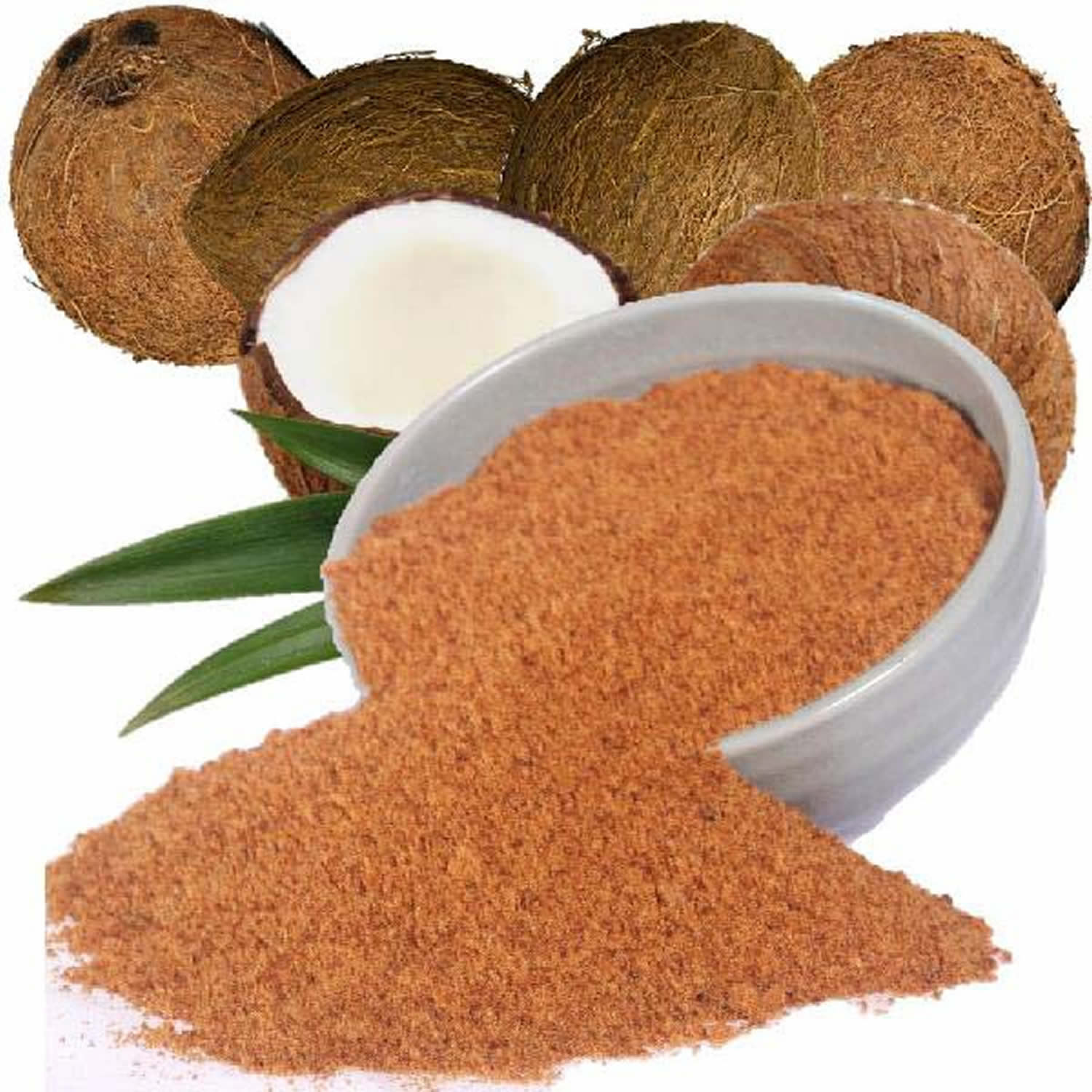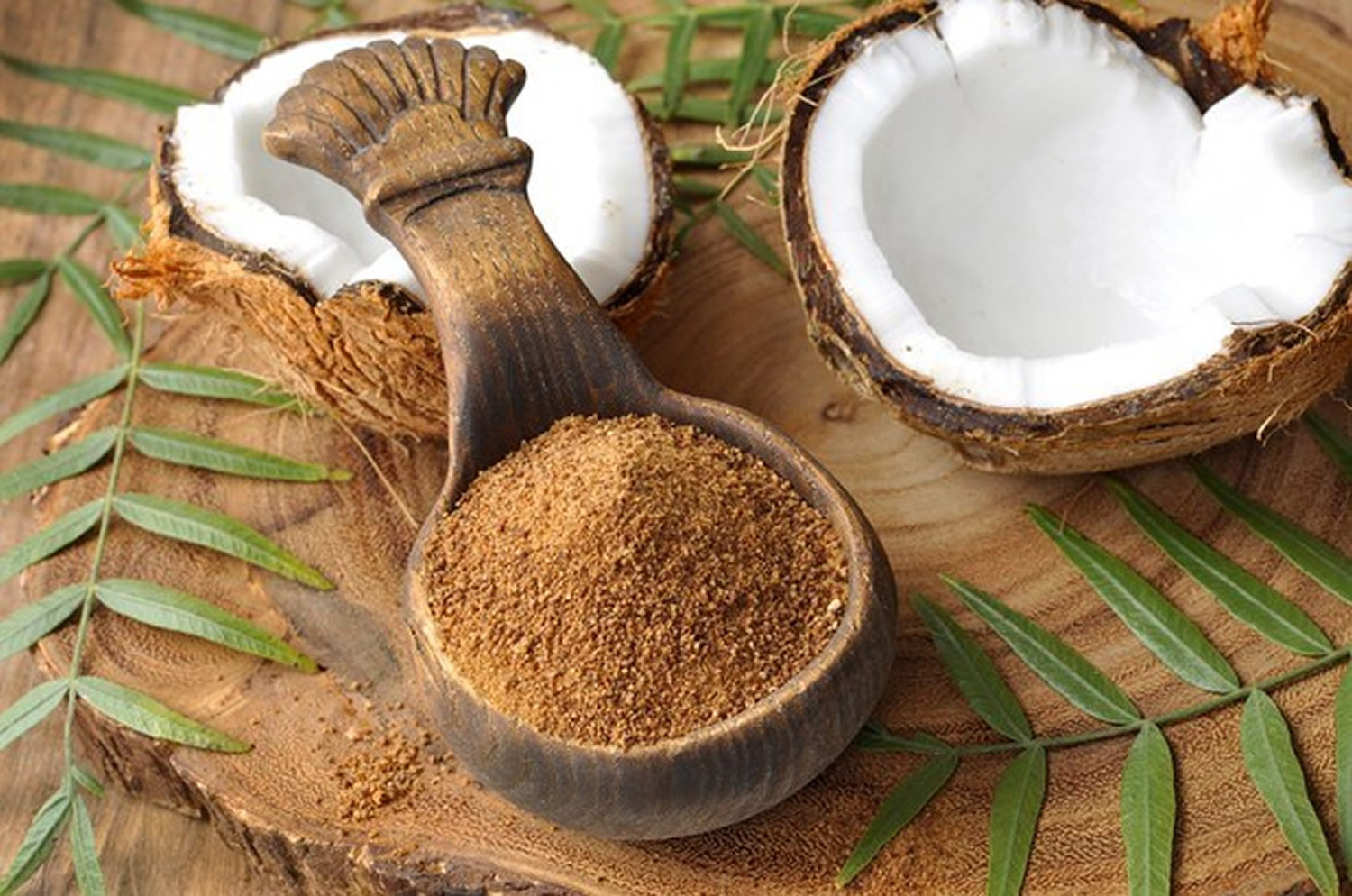
Contents
What is coconut sugar ?
Coconut sugar, sometimes called coconut palm sugar (also known as coco sugar, coco sap sugar or coconut blossom sugar), is made using the sap of cut flower buds of the coconut palm tree. Coconut sugar comes in crystal or granule form, block or liquid. It is essentially a two-step process. It starts with harvesting or “tapping” the blossoms of a coconut tree. Farmers make a cut on the spadix and the sap starts to flow from the cut. The sap is then collected in bamboo containers. The sap collected is then transferred into large woks and placed over moderate heat to evaporate the moisture content of the sap. The sap is translucent and is about 80% water. As the water evaporates, it starts to transform into a thick syrup-like substance known as a “toddy”. From this form, it is further reduced to crystal, block or soft paste form, or it remains in this form.
The major component of coconut sugar is sucrose (70–79%) followed by glucose and fructose (3–9%) each. Minor variations will occur due to differences in primary processing, raw material source, tree age and variety of coconut.
Many coconut sugar makers proudly boast coconut sugar’s ranking on the glycemic index (GI). However, if you are interested in learning and finding about the truth on coconut sugar glycemic index value, you can go to the official website for the glycemic index and international GI (glycemic index) database being maintained in the Boden Institute of Obesity, Nutrition, Exercise and Eating Disorders Centre at the University of Sydney here 1: http://www.glycemicindex.com
What is Glycemic Index of Foods
The glycemic index (GI) is a ranking of carbohydrate foods from 0 to 100 based on how quickly and how much they raise blood sugar (glucose) levels after being eaten 1. This is related to how quickly a carbohydrate containing food is broken down into glucose.
Foods with a high GI are those which are rapidly digested, absorbed and metabolised and result in marked fluctuations in blood sugar (glucose) levels. Low GI carbohydrates – the ones that produce smaller fluctuations in your blood glucose and insulin levels – is one of the secrets to long-term health, reducing your risk of type 2 diabetes and heart disease. It is also one of the keys to maintaining weight loss 1.
Below are examples of foods based on their GI.
Low GI Foods (55 or less)
- 100% stone-ground whole wheat or pumpernickel bread
- Oatmeal (rolled or steel-cut), oat bran, muesli
- Pasta, converted rice, barley, bulgar
- Sweet potato, corn, yam, lima/butter beans, peas, legumes and lentils
- Most fruits, non-starchy vegetables and carrots
Not all low-GI foods are healthy choices – chocolate, for example, has a low-GI because of its fat content, which slows down the absorption of carbohydrate.
Medium GI (56-69)
- Whole wheat, rye and pita bread
- Quick oats
- Brown, wild or basmati rice, couscous
High GI (70 or more)
- White bread or bagel
- Corn flakes, puffed rice, bran flakes, instant oatmeal
- Shortgrain white rice, rice pasta, macaroni and cheese from mix
- Russet potato, pumpkin
- Pretzels, rice cakes, popcorn, saltine crackers
- melons and pineapple
The results from the Glycemic Index International Database 1:
- Coconut sugar GI rating is 54.
- Compare that to regular table sugar, which has an average rating of 58.
As you can see eating coconut sugar has no difference on the glycemic index compared to sugar or eating a banana or pinto beans.
Furthermore, the GI value relates to the food eaten on its own and in practice we usually eat foods in combination as meals. Bread, for example is usually eaten with butter or margarine, and potatoes could be eaten with meat and vegetables. Therefore relying solely on the glycemic index of foods could result in eating unbalanced and un-healthy diets high in fat, salt and saturated fats.
An additional problem is that GI compares the glycaemic effect of an amount of food containing 50g of carbohydrate but in real life we eat different amounts of food containing different amounts of carbohydrate.
Why is the GI important ?
Considering the GI of carbohydrate foods can help with good diabetes management as:
- Lower GI foods produce lower, more stable blood sugar levels and therefore can help improve control of diabetes.
- Higher GI foods produce higher, faster rising blood sugar levels.
- Lower GI foods also help you to feel fuller for longer, which can help to control appetite and assist with weight management.
Remember, GI is not a reflection of how healthy a food is.
- Fat content – Foods high in fat often have a low GI (e.g. chocolate or corn chips) and should only be included occasionally.
- The amount of food eaten- a small amount of a high GI food e.g. watermelon may only have a small effect on blood sugar levels.
- The quality of food- always aim to eat a wide range of carbohydrate containing foods including wholegrain breads and cereals, fresh fruit and vegetables and dairy which provide important nutrients and fibre.
Table 1. Coconut Sugar Nutrition Content
Nutrient | Unit | tsp 4 g | Value per 100 g | ||||||||||||||||
|---|---|---|---|---|---|---|---|---|---|---|---|---|---|---|---|---|---|---|---|
| Approximates | |||||||||||||||||||
| Energy | kcal | 15 | 375 | ||||||||||||||||
| Protein | g | 0.00 | 0.00 | ||||||||||||||||
| Total lipid (fat) | g | 0.00 | 0.00 | ||||||||||||||||
| Carbohydrate, by difference | g | 4.00 | 100.00 | ||||||||||||||||
| Fiber, total dietary | g | 0.0 | 0.0 | ||||||||||||||||
| Sugars, total | g | 4.00 | 100.00 | ||||||||||||||||
| Minerals | |||||||||||||||||||
| Calcium, Ca | mg | 0 | 0 | ||||||||||||||||
| Iron, Fe | mg | 0.00 | 0.00 | ||||||||||||||||
| Sodium, Na | mg | 0 | 0 | ||||||||||||||||
| Vitamins | |||||||||||||||||||
| Vitamin C, total ascorbic acid | mg | 0.0 | 0.0 | ||||||||||||||||
| Vitamin A, IU | IU | 0 | 0 | ||||||||||||||||
| Lipids | |||||||||||||||||||
| Fatty acids, total saturated | g | 0.000 | 0.000 | ||||||||||||||||
| Fatty acids, total trans | g | 0.000 | 0.000 | ||||||||||||||||
| Cholesterol | mg | 0 | 0 | ||||||||||||||||
Table 2. Natural Cane Sugar Nutrition Content
Nutrient | Unit | tsp 4 g | Value per 100 g | ||||||||||||||||
|---|---|---|---|---|---|---|---|---|---|---|---|---|---|---|---|---|---|---|---|
| Approximates | |||||||||||||||||||
| Energy | kcal | 15 | 375 | ||||||||||||||||
| Protein | g | 0.00 | 0.00 | ||||||||||||||||
| Total lipid (fat) | g | 0.00 | 0.00 | ||||||||||||||||
| Carbohydrate, by difference | g | 4.00 | 100.00 | ||||||||||||||||
| Sugars, total | g | 4.00 | 100.00 | ||||||||||||||||
| Minerals | |||||||||||||||||||
| Sodium, Na | mg | 0 | 0 | ||||||||||||||||
| Lipids | |||||||||||||||||||
| Fatty acids, total trans | g | 0.000 | 0.000 | ||||||||||||||||
| Cholesterol | mg | 0 | 0 | ||||||||||||||||
When you compare the nutritional value of coconut sugar to your plain table sugar, both contain the same amount of calories per teaspoon ~ 15 calories or 375 calories per 100 gram.
Coconut sugar as substitute for sugar
Coconut palm sugar is a sugar substitute that seems to be gaining popularity in the market. The taste of pure coconut palm sugar is similar to brown sugar. For cooking purposes, it has a very low melt temperature and an extremely high burn temperature so it can be used baked products in place of sugar 3.
According to the American Diabetes Association 3, it is okay for people with diabetes to use coconut palm sugar as a sweetener, but they should not treat it any differently than regular sugar. It provides just as many calories and carbohydrates as regular sugar: about 15 calories and 4 grams of carbohydrate per teaspoon (see Table 1 and 2 above). So, you still need to account for it when planning meals.
Also, note that some coconut palm sugar on the market may be mixed with cane sugar and other ingredients. It is important to check nutrition labels and read the ingredient list on these products.
Is there difference between organic coconut sugar and non-organic coconut sugar ?
The only difference organic and non-organic is the way the coconut is grown and cultivated. Organic coconut and foods must be free of synthetic additives like pesticides, chemical fertilizers, and dyes, and must not be processed using industrial solvents. Simply stated, organic produce and other ingredients are grown without the use of pesticides, synthetic fertilizers, sewage sludge, genetically modified organisms, or ionizing radiation. Animals that produce meat, poultry, eggs, and dairy products do not take antibiotics or growth hormones. You may want to learn more about organic foods by going to “Are Organic foods healthier for you to eat ?”
Is coconut sugar good for you ?
Now you have a better understanding and knowledge on coconut sugar, this question is like asking “Is eating sugar good for you ?” or is eating sugar healthy ?
According to the latest Dietary Guidelines for Americans (designed to help Americans eat a healthier diet) published by the U.S. Department of Health and Human Services 4:
- Consume less than 10 percent of calories per day from added sugars 4
U.S. Department of Health and Human Services – Dietary Guidelines “limit calories from added sugars to less than 10 percent per day is a target based on food pattern modeling and national data on intakes of calories from added sugars that demonstrate the public health need to limit calories from added sugars to meet food group and nutrient needs within calorie limits. For most calorie levels, there are not enough calories available after meeting food group needs to consume 10 percent of calories from added sugars and 10 percent of calories from saturated fats and still stay within calorie limits.”
Perhaps you may be interested in another article we wrote on sugar by going to “The Truth About Sugar.”
Is coconut sugar paleo ?
A paleo diet (Caveman Diet) is a dietary plan based on foods similar to what might have been eaten during the Paleolithic era, which dates from approximately 2.5 million to 10,000 years ago. This diet consists of foods that are assumed to have been available to humans prior to the establishment of agriculture. The principal components of this diet are wild-animal source and uncultivated-plant source foods, such as lean meat, fish, vegetables, fruits, roots, eggs, and nuts. The diet excludes grains, legumes, dairy products, salt, refined sugar, and processed oils, all of which were unavailable before humans began cultivating plants and domesticating animals.
So the answer to that question, is coconut sugar is definitely no.
You can learn more about paleo and the paleo diet by going to “The Paleo Diet.”
- Glycemic Index International Database, University of Sydney. http://www.glycemicindex.com[↩][↩][↩][↩]
- United States Department of Agriculture, Agriculture Research Service. USDA Food Composition Databases. https://ndb.nal.usda.gov/ndb/[↩][↩]
- American Diabetes Association. Coconut Palm Sugar. http://www.diabetes.org/food-and-fitness/food/what-can-i-eat/making-healthy-food-choices/coconut-palm-sugar.html [↩][↩]
- U.S. Department of Health and Human Services. 2015–2020 Dietary Guidelines for Americans. https://health.gov/dietaryguidelines[↩][↩]





